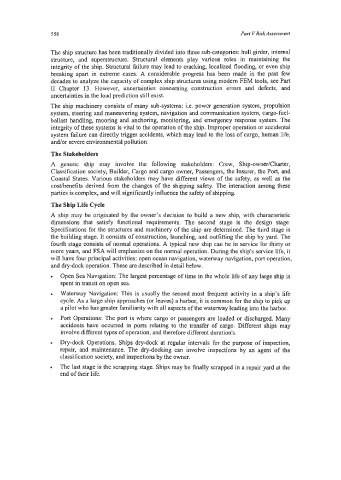Page 582 - Marine Structural Design
P. 582
558 Pari V Risk Assessment
The ship structure has been traditionally divided into three sub-categories: hull girder, internal
structure, and superstructure. Structural elements play various roles in maintaining the
integrity of the ship. Structural failure may lead to cracking, localized flooding, or even ship
breaking apart in extreme cases. A considerable progress has been made in the past few
decades to analyze the capacity of complex ship structures using modem FEM tools, see Part
I1 Chapter 13. However, uncertainties concerning construction errors and defects, and
uncertainties in the load prediction still exist.
The ship machinery consists of many sub-systems: i.e. power generation system, propulsion
system, steering and maneuvering system, navigation and communication system, cargo-fuel-
ballast handling, mooring and anchoring, monitoring, and emergency response system. The
integrity of these systems is vital to the operation of the ship. Improper operation or accidental
system failure can directly trigger accidents, which may lead to the loss of cargo, human life,
and/or severe environmental pollution.
The Stakeholders
A generic ship may involve the following stakeholders: Crew, Ship-ownerKharter,
Classification society, Builder, Cargo and cargo owner, Passengers, the Insurer, the Port, and
Coastal States. Various stakeholders may have different views of the safety, as well as the
costibenefits derived from the changes of the shipping safety. The interaction among these
parties is complex, and will significantly influence the safety of shipping.
The Ship Life Cycle
A ship may be originated by the owner's decision to build a new ship, with characteristic
dimensions that satisfy functional requirements. The second stage is the design stage.
Specifications for the structures and machinery of the ship are determined. The third stage is
the building stage. It consists of construction, launching, and outfitting the ship by yard. The
fourth stage consists of normal operations. A typical new ship can be in service for thirty or
more years, and FSA will emphasize on the normal operation. During the ship's service life, it
will have four principal activities: open ocean navigation, waterway navigation, port operation,
and dry-dock operation. These are described in detail below.
Open Sea Navigation: The largest percentage of time in the whole life of any large ship is
spent in transit on open sea.
Waterway Navigation: This is usually the second most frequent activity in a ship's life
cycle. As a large ship approaches (or leaves) a harbor, it is common for the ship to pick up
a pilot who has greater familiarity with all aspects of the waterway leading into the harbor.
Port Operations: The port is where cargo or passengers are loaded or discharged. Many
accidents have occurred in ports relating to the transfer of cargo. Different ships may
involve different types of operation, and therefore different duration's.
Dry-dock Operations. Ships dry-dock at regular intervals for the purpose of inspection,
repair, and maintenance. The dry-docking can involve inspections by an agent of the
classification society, and inspections by the owner.
The last stage is the scrapping stage. Ships may be finally scrapped in a repair yard at the
end of their life.

